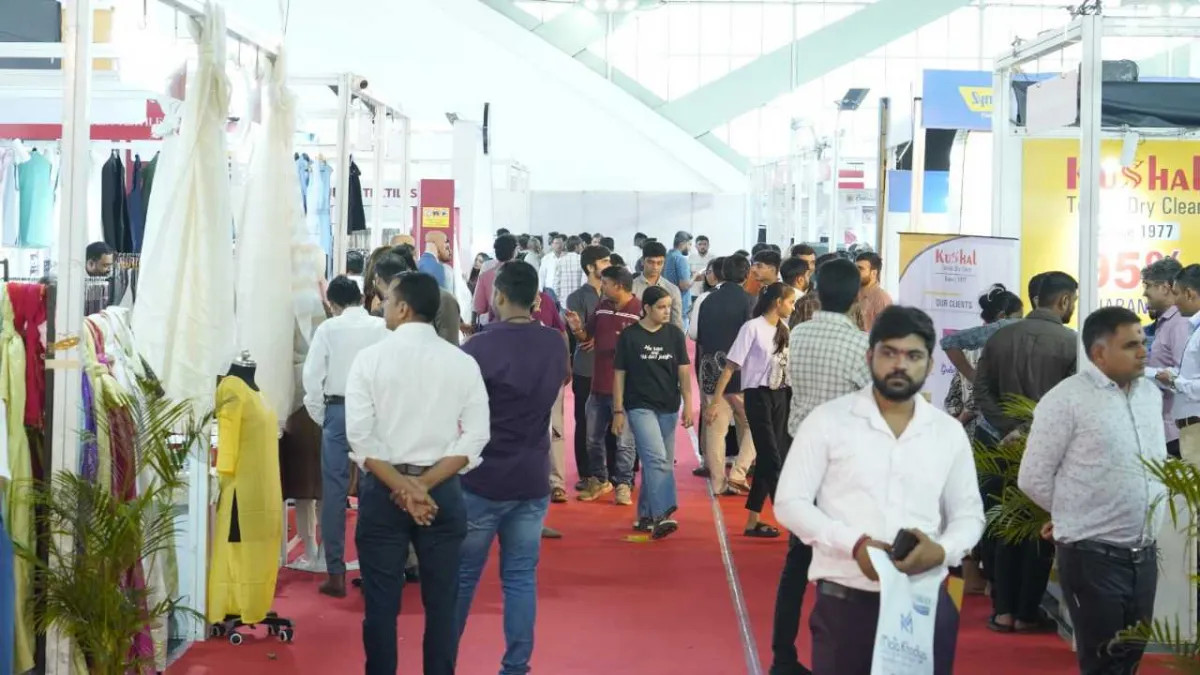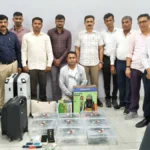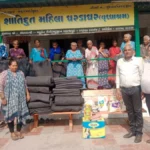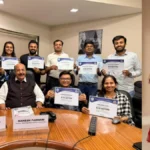Surat’s Textile Strength Gains National Recognition; Exhibition Becomes a Fusion of Tradition, Technology, and Innovation
Surat. The Vivinite Exhibition-2025, organized by the South Gujarat Chamber of Commerce and Industry at the Surat International Exhibition and Convention Centre in Sarasana, is achieving tremendous success. In the first two days, over 6,380 visitors and more than 580 genuine buyers from various cities across India participated.
The exhibition aims to provide a robust business platform for weavers, technical textile manufacturers, and entrepreneurs associated with the traditional textile industry in South Gujarat. Exhibitors have received large orders for millions of meters of gray fabric, traditional sarees, and fashionable garments.
The exhibition saw the presence of buyers and corporate representatives from across the country. Textile buyers and corporate procurement managers from major textile markets such as Indore, Jaipur, Pune, Delhi, Lucknow, Bangalore, Ludhiana, Kolkata, and Chennai participated. Exhibitors not only secured orders but also established new business relationships.
The exhibition highlights modern technologies and products in the textile industry.
Technical Textiles: Antimicrobial, waterproof, and fire-resistant fabrics such as hospital curtains, shower curtains, blackout, and whiteout fabrics. Microfiber Products: Bed sheets, duvet covers, pillow covers, and ultrasonic fabrics.
Traditional & Fashion Apparel: A vibrant collection of fabrics including Dola Silk, Tissue Silk, Viscose, Muslin Silk, Denim, Cotton Twills, Chiffon, and Linen. Digital Technology: Visitors at the “Gosetu” stall experienced remote-controlled weaving technology, enabling loom operation via remote control. This innovation signals a revolutionary change in the weaving industry.
Sections dedicated to sustainable materials, technical textiles, and modern weaving techniques are particularly popular. Meanwhile, stalls by real estate companies provide information on setting up industrial parks and textile units.
According to organizers, the third day of the exhibition on Sunday is expected to be even busier, with a large turnout of general visitors and domestic buyers anticipated.
Vivinite Exhibition-2025 has not only provided Surat’s textile industry with a business platform but has also played a key role in establishing its innovation, quality, and potential on the national stage. The exhibition has become an impressive convergence of technology, tradition, and future possibilities.
Surat International Exhibition and Convention Centre
The Surat International Exhibition and Convention Centre (SIECC) is a modern venue in Surat, Gujarat, designed to host large-scale exhibitions, trade fairs, and conferences. Established to support Surat’s growing prominence as a business and diamond trading hub, it facilitates both domestic and international events. The center reflects the city’s economic vibrancy and plays a key role in promoting trade and industry in the region.
South Gujarat Chamber of Commerce and Industry
The South Gujarat Chamber of Commerce and Industry (SGCCI) is a prominent trade organization based in Surat, Gujarat, established in 1949 to promote business and industrial growth in the region. It plays a key role in supporting local enterprises, facilitating trade, and advocating for economic policies. Over the decades, SGCCI has contributed significantly to the development of South Gujarat as a major industrial and commercial hub.
Vivinite Exhibition-2025
The *Vivinite Exhibition-2025* is a contemporary cultural event showcasing innovative art, technology, and design, aimed at fostering creativity and global collaboration. Inspired by historical avant-garde movements, it features interactive installations, digital art, and sustainable design from emerging and established artists worldwide. The exhibition’s name, *Vivinite*, reflects its mission to celebrate vibrant, living (*vivi*) creativity and unity (*nite*), continuing a legacy of boundary-pushing cultural exchange.
Gosetu
There is no widely recognized cultural or historical site known as “Gosetu.” It may refer to a lesser-known location, a misspelling, or a term from a specific regional or cultural context. If you have additional details or a different spelling, please provide them so I can offer a more accurate summary.
Dola Silk
Dola Silk is a traditional handwoven silk fabric from Assam, India, known for its vibrant colors and intricate designs. Historically, it has been produced by local weavers, often women, using age-old techniques passed down through generations. The silk holds cultural significance in Assam and is commonly used for traditional attire like mekhela chadors and saris.
Tissue Silk
“Tissue Silk” (often called *Tissus Silk* or *Tissue Silk Fabric*) refers to a delicate, lightweight silk fabric known for its fine, gauzy texture, often used in luxurious garments and historical textiles. Originating from ancient silk-weaving traditions, particularly in regions like China, India, and Persia, it became highly prized in Europe during the Renaissance and Baroque periods for its sheer, shimmering quality. Today, it remains a symbol of elegance, often used in haute couture and special occasion wear.
Muslin Silk
“Muslin Silk” refers to the fine, lightweight cotton fabric known as muslin, historically produced in regions like Dhaka (modern-day Bangladesh) and exported globally. Originating in ancient times, it became highly prized during the Mughal era (16th–18th centuries) for its delicate texture, often compared to silk. Though not actual silk, its luxurious quality earned it the nickname “Muslin Silk,” symbolizing the craftsmanship of South Asian weavers before colonial policies disrupted its production.
Cotton Twills
“Cotton Twills” likely refers to a type of durable, woven cotton fabric characterized by its diagonal rib pattern, historically used for workwear, military uniforms, and casual clothing like jeans and jackets. The twill weave technique dates back centuries, with cotton twills becoming especially popular during the Industrial Revolution due to their strength and versatility. Today, they remain a staple in fashion and textiles, valued for their comfort and durability.
(If “Cotton Twills” refers to a specific brand or cultural site, please provide additional details for a more accurate summary.)






